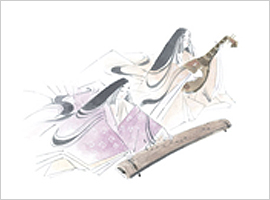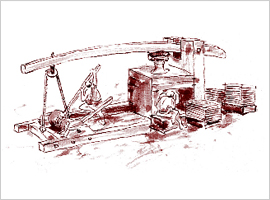HISTORY OF INCENSE
Koh, Incense History in Japan
The Tumulus Period
AD538 The arrival of Buddhism to Japan, and incense use was transmit through Buddhist rituals
AD595 Agarwood drifts ashore to Awaji Island
It seems that the beginning of Koh, incense in Japan date from the same period as the arrival of Buddhism to Japan.“Nihon Shoki,”the first Japanese history book, states that in AD595, a sizeable chunk of agarwood drifted ashore at Awaji Island. When the island’s inhabitants burned the chunk, they noticed a wonderful new aroma. The locals presented the wondrous wood to the imperial court.
The Nara Period
AD710 The relocation of the Heijokyo Capital, Nara prefecture
AD754 The visit of Ganjin (Jianzhen), who was a Chinese monk to Japan
He introduced the precepts of Buddhism, as well as many of the ingredients of used in Koh (Incense).The fabrication process of “Takimono” (Kneaded Incense) also arrived around this period.
In the Nara period, it is said that the ingredients of incense were burned directly. In this context, it is strongly believed that incense was used as a religious object because of its use as “Ku-koh,” for purifying Buddha and avoiding maliciousness.
The Heian Period

In AD 794, amidst the relocation of the Heiankyo Capital, Kyoto prefecture, various kinds of incense ingredients were imported to Japan from overseas. Takimono, or "Kneaded Incense," was the main kind of incense used in this time, and it was the result of the blending of many of these select ingredients. Japanese people embraced this type of fragrance. The enjoyment of elegant fragrance became a custom of daily life for the aristocracy. Literature of the Heian Period, such as "Makura-no-soushi" (The Pillow Book) and "Genji Monogatari" (The Tale of Genji), included many passages and references about Koh."
The Kamakura Period
AD1192 The Kamakura government was founded by Yoritomo MINAMOTONO, the first shogun of the dynasty. The rise of warriors' status
Until this time period, "Takimono" (kneaded incense) had been the most popular form of incense with the aristocracy. Now, the pure fragrance of Agarwood itself was becoming more popular.
The Muromachi Period
In AD 1338, the Muromachi government was founded by Takauji ASHIKAGA, the first shogun of the dynasty. Nearly 60 years later, the Kinkakuji Temple was built by Yoshimitsu ASHIKAGA, the third shogun of the dynasty. The Ginkakuji Temple was constructed by Yoshimasa ASHIKAGA, the eight shogun of the dynasty, in AD1489. During this progression of the Higashiyama culture, incense ceremony, much like tea ceremony and flower arrangement, became a kind of "Yoriai-no-Geido," a gathering to appreciate the arts. Koh-do had established itself as a unique art in Japan, and a preference for the appreciation of aromatic wood grew among warriors. At the time, much of the good aromatic wood was imported to Japan via its successful trade relationship with China. It is said that Doyo SASAKI, a well known figure in the book of "Taiheiki" (a Japanese historical epic), collected hundreds of varieties of aromatic wood.
The Edo Period

AD1603 The Edo government was founded by Ieyasu TOKUGAWA, the first shogun of the dynasty. Koh-do, Incense Ceremony flourished. During this period, the process of manufacturing stick-shaped incense was imported from China. Stick incense was the style of Koh that was primarily used by the Japanese middle class. Koh-do, Incense Ceremony which had been developed in the Muromachi period, was now being adopted by the commoner. As times change, Japanese incense manufacturers are continually developing new fragrances fitting for today's lifestyle in Japan; in the process, they are creating a new incense history.
CULTURE
- HISTORY OF INCENSE
- INCENSE CEREMONY
- LISTENING TO INCENSE
- VIRTUES OF KOH

